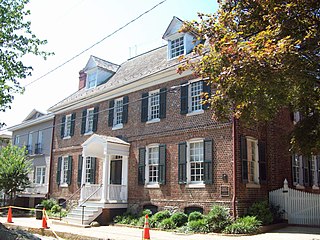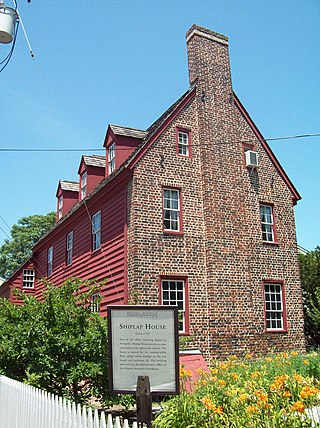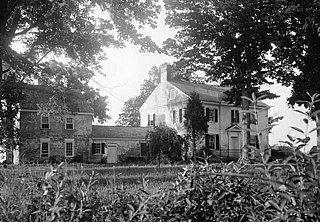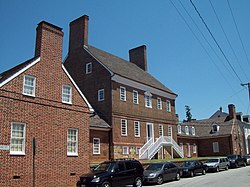
Annapolis is the capital city of the U.S. state of Maryland and the county seat of, and only incorporated city in, Anne Arundel County. Situated on the Chesapeake Bay at the mouth of the Severn River, 25 miles (40 km) south of Baltimore and about 30 miles (50 km) east of Washington, D.C., Annapolis forms part of the Baltimore–Washington metropolitan area. The 2020 census recorded its population as 40,812, an increase of 6.3% since 2010.

William Buckland (1734–1774) was a British architect who designed several important buildings in colonial Maryland and Virginia.

The Hammond–Harwood House is a historic house museum at 19 Maryland Avenue in Annapolis, Maryland, USA. Built in 1774, is one of the premier colonial houses remaining in America from the British colonial period (1607–1776). It is the only existing work of colonial academic architecture that was principally designed from a plate in Andrea Palladio's I Quattro Libri dell'Architettura (1570). The house was designed by the architect William Buckland in 1773–1774 for wealthy farmer Matthias Hammond of Anne Arundel County, Maryland. It was modeled on the design of the Villa Pisani in Montagnana, Italy, as depicted in Book II, Chapter XIV of Palladio's work. It was designated a National Historic Landmark in 1960, and is now managed by a non-profit organization as a museum.
John Randall was an architect, American Revolutionary War soldier and officer, and was an early 19th-century mayor of Annapolis, Anne Arundel County, Maryland. He was also the Collector of the Port of Annapolis, which included responsibility for fortifying the harbor.

The Belair Mansion, located in the historic Collington area and in Bowie, Maryland, United States, built c. 1745, is the Georgian style plantation house of Provincial Governor of Maryland, Samuel Ogle. Later home to another Maryland governor, the mansion is listed on the National Register of Historic Places.

Located south of Laurel in Prince George's County, Maryland, United States, Montpelier Mansion is a five-part, Georgian style plantation house most likely constructed between 1781 and 1785. It has also been known as the Snowden-Long House, New Birmingham, or simply Montpelier. Built by Major Thomas Snowden and his wife Anne, the house is now a National Historic Landmark operated as a house museum. The home and 70 acres (28 ha) remain of what was once a slave plantation of about 9,000 acres (3,600 ha).

The William Brown House, also known as London Town Publik House or Londontowne Public House, is a former Colonial tavern located in the Historic London Town and Gardens museum complex in Woodland Beach, Anne Arundel County, Maryland. Completed in 1764, it is one of the best-preserved examples of a colonial-era brick tavern house. From 1828 to 1965 the structure was used as a county alms house. It was declared a National Historic Landmark in 1970.

The William Paca House is an 18th-century Georgian mansion in Annapolis, Maryland, United States. Founding Father William Paca was a signatory of the Declaration of Independence and a three-term Governor of Maryland. The house was built between 1763 and 1765 and its architecture was largely designed by Paca himself. The 2-acre (8,100 m2) walled garden, which includes a two-story summer house, has been restored to its original state.

The Chase–Lloyd House is a historic house at 22 Maryland Avenue in Annapolis, Maryland. Built in 1769–1774, it is one of the first brick three-story Georgian mansions to be built in the Thirteen Colonies, and is one of the finest examples of the style. Its interiors were designed by William Buckland. Its construction was started for Samuel Chase, who would later be a signatory to the Declaration of Independence and Associate Justice of the Supreme Court, but Chase sold the building unfinished to Edward Lloyd IV in 1771. Lloyd completed the house in 1774 with assistance from Buckland and another architect, William Noke. The house remained in the Lloyd family until 1847, when it was sold to a relation of Chase. Hester Anne Chase was the daughter of Jeremiah Townley Chase who was Samuel Chase's cousin. When she died, she left the house to her 3 orphan nieces, Francis, Matilda, and Hester. In 1888 the house was bequeathed for use as a home for elderly women by the will of the last living niece, Hester. It continues in this use today. While the upper floors are off limits to visitors, the main floor and the extensive gardens are open to the public.

Whitehall is a colonial home that was built beginning in 1764 near Annapolis in Anne Arundel County in the Province of Maryland by Horatio Sharpe, then the provincial governor of the British colony of Maryland.

Tulip Hill is a plantation house located about one mile from Galesville in Anne Arundel County in the Province of Maryland. Built between 1755 and 1756, it is a particularly fine example of an early Georgian mansion, and was designated a National Historic Landmark in 1970 for its architecture.

The Peggy Stewart House, also known as the Rutland-Jenifer-Stone House, is a Georgian style house in Annapolis, Maryland. Built between 1761 and 1764 by Thomas Rutland as a rental property, it was owned at various times by Thomas Stone and U.S. Founding Father Daniel of St. Thomas Jenifer. In October 1774 it was owned by Anthony Stewart, owner of the ship Peggy Stewart. It was listed in the National Register of Historic Places in 1973 for its associations with the burning of Anthony Stewart's ship, Peggy Stewart, as well as for its architectural significance as a mid- to late 18th century Georgian mansion. Furthermore, the dwelling was recognized as a National Historic Landmark for its associations with Jenifer and Stone, and for the thematic representation of politics and diplomacy during the American Revolution

Riversdale, is a five-part, large-scale late Georgian mansion with superior Federal interior, built between 1801 and 1807. Also known as Baltimore House, Calvert Mansion or Riversdale Mansion, it is located at 4811 Riverdale Road in Riverdale Park, Maryland, and is open to the public as a museum.

The Colonial Annapolis Historic District is a historic district in the City of Annapolis, the state capital of Maryland, that was designated a National Historic Landmark District in 1965 and was geographically further expanded in 1984.

John Callahan House, known previously as Pinkney-Callahan House when it was located on St. John Street, is a historic home in Annapolis, Maryland, United States. The brick home was constructed by John Callahan, a prominent and wealthy Annapolitan who served as the Register of the Western Shore Land Office between 1778 and 1803, around 1785–90. It has been moved twice in efforts to prevent its demolition. In 1900–01, the house was relocated to St. John's Street and then to its present site on Conduit Street in 1972. The home features an unusual gable-end principal façade and a largely intact Georgian/Federal interior finishes. It once served as St. John's College Infirmary.

Primrose Hill is a historic home at 3 Milkshake Lane in Annapolis, Anne Arundel County, Maryland. It is a 2+1⁄2-story, four-bay, double-pile brick house with interior end chimneys. It is of mid-18th-century Georgian design and construction, and the property is historically important with its direct association to the American portraitist, John Hesselius (1728–1778), who resided in this house between about 1763 and his death.

The Upton Scott House is a historic home in Annapolis, Anne Arundel County, Maryland, United States. It is a 2+1⁄2-story, rectangular brick house. The interior is lavish, and the house has sustained only minor alterations in the 20th century. The house was built for Dr. Upton Scott, the personal physician to the Royal Governor of the Province of Maryland, and is of the transitional Georgian style. The house was built by William Brown, and closely resembles Brown's house on the South River, now known as the London Town Publik House.

Larkin's Hill Farm is a historic home at Harwood, Anne Arundel County, Maryland, United States. It is a 1+1⁄2-story gambrel-roofed brick house with a 20th-century wing. In 1683 the estate served as a temporary capital of Maryland. John Larkin, an early Quaker settler in the area, later operated an inn here as a stopping place on the first regular postal route in Maryland, which ran from St. Mary's City to Annapolis. The present brick house was built during the ownership of Lord High Sheriff of Annapolis Captain John Gassaway, the grandson of pioneer politician Colonel Nicholas Gassaway, shortly after his acquisition of the property in 1753.

Larkin's Hundred, also known as The Castle, is a historic home at Harwood, Anne Arundel County, Maryland, United States. It is a two-story brick house. Although tradition holds that it was built in 1704 by Thomas Larkin, a son of John Larkin of nearby Larkin's Hill Farm, evidence suggest it was actually constructed in the second quarter of the 18th century for Captain Joseph Cowman, a mariner and wealthy Quaker. A white clapboard kitchen wing at the west end was added in 1870. A noteworthy interior feature is a graceful stairway of American walnut.

Kingston Hall is a historic home located at Kingston, Somerset County, Maryland. Located along the Big Annemessex River, it is a Georgian style dwelling of two stories plus an attic, three bays wide by two deep, connected by a one-story brick hyphen to a two-story-plus-loft brick kitchen wing. Also on the property is the brick, circular ice house. The interior of the house features corner fireplaces. Interior woodwork mouldings are in a transitional style, bridging late Georgian and Federal styles.
7. Beckerdite, Luke. “William Buckland Reconsidered: Architectural Carving in Chesapeake, Maryland 1771-1774”, Journal of Early Southern Decorative Arts, Vol. VIII, No. 2, November 1982, pp. 43–88

























